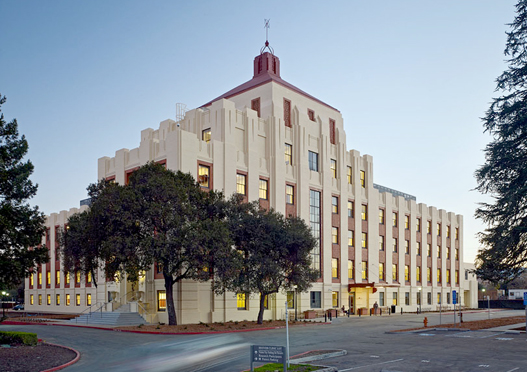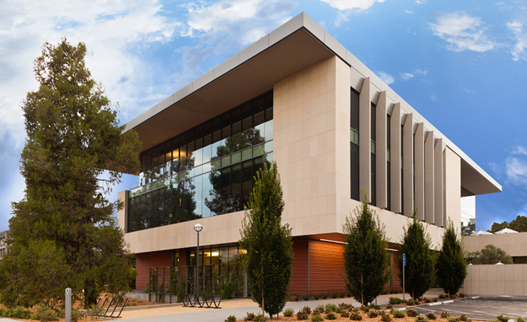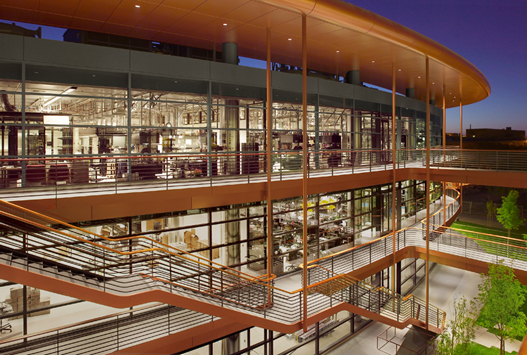Stanford Facilities - Neurology & Neurological Sciences
New Stanford Hospital and Clinics
Stanford Hospital & Clinics is a 621-bed facility located in the San Francisco Bay Area with an emphasis on advanced patient care. It provides tertiary care of rare and complex disorders for much of northern California and the West Coast, in addition to serving the region as a level one trauma center. It is home to one of the nation's first certified stroke centers, and in 2012 Stanford Hospital was the first in the nation to earn the comprehensive stroke center designation. The Neurology Inpatient Service is typically very busy. Its volume has steadily grown over the past decade and is amongst the highest of all Californian university hospitals. The Neuroscience Outpatient Clinic handles over 20,000 patient visits a year in its general and subspecialty neurology and neurosurgery clinics. Neurodiagnostic services include EEG, EMG, video monitoring, polysomnography, evoked potentials, intraoperative monitoring, transcranial doppler, genetic counseling, neuropsychological testing, and the only full autonomic testing laboratory in Northern California. Neuroradiology provides PET, MR spectroscopy and other functional imaging studies in addition to all the traditional imaging services.
For project updates, visit us at Stanford University Medical Center Project: Renewal

New Lucile Salter Packard Children's Hospital
The Children’s Hospital adjoins the Stanford University Hospital, and is dedicated to the care of children with acute and chronic diseases. The hospital has 311 licensed beds and a medical staff of around 800. Neurology provides inpatient care, consultative service and outpatient care, as well as a full range of ancillary services like those on the adult neurology service.
For project updates, visit us at Stanford University Medical Center Project: Renewal

Hoover Pavilion (Hoover-1)
Hoover Pavilion, the original Palo Alto Hospital, has been completely renovated to accommodate the practice of modern medicine. Now complete, the improved facility houses outpatient Internal Medicine clinics as well as an extension of the Neurology Clinics. The expanded space allows an innovative multidisciplinary approach to care that teams neurologists with physical, occupational, speech and respiratory therapists, clinical social worker, genetic counselor, research assistant, and advanced care providers.


Freidenrich Center for Translational Research
The Freidenrich Center is Stanford's hub for innovative, collaborative and interdisciplinary translational research, to allow clinical and research programs to come together in the development of new drugs and therapies for patients.
The Stanford University Medical Center officially opened the Jill and John Freidenrich Center for Translational Research on Oct. 17 2012, advancing the capabilities of researchers across the university to conduct the vital clinical research that translates basic science discoveries into lifesaving treatments and diagnostics.

Li Ka Shing Center for Learning and Knowledge
The Li Ka Shing Center for Learning and Knowledge at Stanford University School of Medicine brings together cutting-edge medicine, modern education and advanced technology, by design. Aspiring doctors practice life-saving skills in the safety of realistic simulations. Researchers have instant access to the most current data without leaving their labs. Medical experts from around the world gather to share the latest insights and bring their combined expertise to bear on the great health challenges of our time.
Lorry I. Lokey Stem Cell Research Building
Stanford’s new Lorry I. Lokey Stem Cell Research Building (SIM1), a California Institute for Regenerative Medicine facility, is the largest building in the world devoted exclusively to stem cell research. Opened in 2011, it brings under one roof researchers from multiple specialties and disciplines, allowing them to collaborate in exploring the astonishing potential of stem cells to address injuries and disease.
James H. Clark Center
The Clark Center lies at the heart of the Stanford campus between the core campus science engineering buildings and the hospital and medical facilities. Located on primary routes between the campus and the medical center, the building acts as a social magnet encouraging encounters and informal meetings between lecturers, researchers and students from diverse academic backgrounds. The lab interiors are a dramatic departure from tradition. The building has been turned inside out, with 'corridors' replaced by external balconies, enabling completely flexible lab layouts.
The three-story building takes the form of three wings of laboratories centered on an open courtyard overlooked by balconies. A large restaurant is located on the ground floor. Structurally the building combines rigidity with flexibility to facilitate the use of highly sensitive equipment such as lasers and also to withstand seismic activity. The building's rich palette of materials echoes both the red-tiled roofs and limestone facades typical of the Stanford vocabulary of other central campus buildings and the architectural form of the medical center.
Stanford Cancer Center
The Stanford Cancer Center offers health professionals a unique atmosphere where patient care is a priority, access to cutting-edge technologies and treatments is commonplace, and professional development is valued. Under one roof, the Cancer Center brings together cutting-edge technologies for both diagnosis and treatment. This consolidation of technology makes it convenient to deliver the best possible care to your patients and monitor their progress. With access to the CyberKnife, CAD-assisted digital mammography, and cutting-edge brachytherapy (just to name a few), and a large number of clinical trials, it enables expeditious delivery of best treatments for patients.

Veterans Administration Palo Alto Health Care System
The hospital has 235 medical-surgical beds and additional psychiatric beds. This facility is located approximately five miles from the Stanford University Hospital, and is home to a positron emission tomography (PET) unit as well as important programs in radiology, psychiatry, rehabilitation medicine, geriatrics and spinal cord rehabilitation. Neurology provides busy inpatient consultation services, outpatient clinics, as well as clinical neurophysiology and neuropathology services. The medical center is also home to several important basic neuroscience research programs.

Santa Clara Valley Medical Center Santa Clara, CA
This 574-bed medical center cares for thousands of patients and provides for over a half-million outpatient and emergency visits every year. It is a level one trauma center for Santa Clara county, one of the most populous counties in the Bay Area. With its open door policy guaranteeing residents access to medical care, it serves the medically indigent patients of Santa Clara county as well as culturally and ethnically diverse patient populations.
The neurology service comprises an active inpatient consultation service and a busy outpatient clinic. Attending physicians, all members of the Stanford faculty, are actively involved in bedside teaching, weekly conferences, and the supervision of patient care. Trainees are exposed to a very wide range of acute and chronic neurologic disorders.




